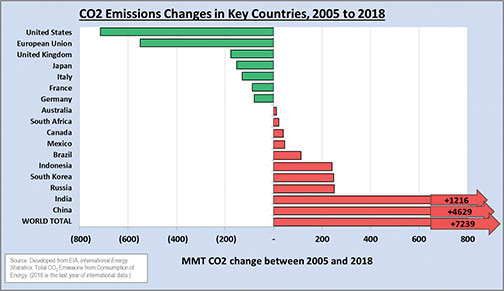By Dan Byers
 Several years ago, a group of state government officials coined the phrase “The Greatest Story Seldom Told” to describe the incredible progress that the United States has made in reducing emissions, and America’s underappreciated standing as having one of the best and cleanest environments in the world. Despite even more progress and renewed focus on our climate and the environment, that story is still seldom told.
Several years ago, a group of state government officials coined the phrase “The Greatest Story Seldom Told” to describe the incredible progress that the United States has made in reducing emissions, and America’s underappreciated standing as having one of the best and cleanest environments in the world. Despite even more progress and renewed focus on our climate and the environment, that story is still seldom told.
Perhaps now more than ever, Americans are concerned about the growing challenge of climate change. The Biden Administration is rightfully focused on American participation in the United Nations Paris Agreement, while Congress has advanced the most significant energy and climate legislation in decades.
 For many reasons, we can, and must, do more to address climate and environmental issues. But that should not diminish the remarkable progress that has already been made, thanks to the widespread availability of natural gas, greater use of renewables, energy efficiency and other innovations. The business community has led the way, with billions invested in new technologies.
For many reasons, we can, and must, do more to address climate and environmental issues. But that should not diminish the remarkable progress that has already been made, thanks to the widespread availability of natural gas, greater use of renewables, energy efficiency and other innovations. The business community has led the way, with billions invested in new technologies.
Unfortunately, there’s a disconnect between the progress being made to reduce emissions and the public awareness of these efforts. This year’s Gallup annual survey of Americans’ views on a number of environmental issues shows that 52 percent of Americans believe that the quality of the environment in the U.S. is getting worse. With respect to air quality specifically, 73 percent of Americans say they worry about air pollution either a great deal or a fair amount.
With that in mind, let’s take a closer, sector-by-sector look at some of the important progress that should encourage Americans concerned about our planet:
Cleaner Electricity

The electric power sector is leading the way in emissions reductions. Consider:
- According to EPA data, between 2005 and 2019, emissions of sulfur dioxide (SO2) and nitrogen oxides (NOX) from electricity generation were reduced by 90 percent and 75 percent, respectively.
- Between 2005 and 2019, power sector carbon dioxide (CO2) emissions fell by 32 percent, powered in large part by the shale revolution making natural gas more plentiful and affordable.
- Today, 40 percent of all U.S. power generation comes from emissions-free sources, including nuclear energy, hydropower, wind and solar energy.??
- Nuclear energy remains the largest source of emissions-free electricity, with 94 reactors in 28 states generating about 55 percent of the nation’s emissions-free electricity.
- Emissions-free wind and solar generation is growing rapidly, and future technological breakthroughs in these areas as well as emergent technologies such as grid-scale storage, advanced nuclear, and carbon capture and sequestration hold even more promise for the future.
- Energy efficiency also contributes greatly to this progress. It now takes 40 percent less energy to produce a dollar of GDP than it did in 1990.
- As we look to the future, the power sector will not only continue to get cleaner, it will enable other sectors to reduce emissions as well. Advances in the efficiency and affordability of battery storage technologies have enabled the introduction of over 50 different models of electric vehicles, sparking a trend that is only expected to accelerate. By 2023, automakers will have invested more than $250 billion in electrification.
- Moreover, the Energy Information Administration’s latest 2021 forecast suggests that even as U.S. electricity generation grows by 12 percent between 2020 and 2035, we will nonetheless benefit from declining emissions of SO2 (26 percent), NOX (37 percent), mercury (15 percent) and CO2 (18 percent).
Cleaner Transportation
There has also been a great deal of progress on vehicle emissions. The increasing availability of hybrids and electric vehicles along with widespread use of more advanced powertrains, sensors and emissions control technologies have significantly improved the environmental footprint of our 260 million strong vehicle fleet. For example:
- Since 2000, EPA data shows that transportation emissions of ozone-forming nitrogen oxides and volatile organic compounds (VOCs) have declined by 67 percent and 72 percent, respectively, even as total vehicle miles traveled increased by 14 percent. During the same period, SO2 emissions have decreased an incredible 96 percent. (We use 2019 data as 2020 figures are significantly distorted by COVID-related impacts, as described here.)
- By 2025, it is expected that ozone-forming emissions of hydrocarbons and nitrogen oxides from passenger vehicles are nearly 98 percent lower than when emissions controls were first implemented.
- Government and industry are working collaboratively to address emissions from medium- and heavy-duty trucks as well. Because of the long operational lives of diesel engines used to power freight vehicles, fleet turnover is an important factor to reducing emissions. In December, Congress reauthorized and provided a record $90 million for the U.S. Chamber-supported Diesel Emissions Reduction Act, a program that provides grants to replace or upgrade older truck engines, often reducing pollutant emissions by more than 90 percent.
Cleaner Manufacturing and Industry
The contributions from America’s industrial sector to air quality improvements are often overlooked, but they shouldn’t be.
- According to EPA’s National Emissions Inventory, industrial emissions of SO2, NOx, and fine particulate matter (PM2.5) have declined by 82 percent, 62 percent and 29 percent, respectively, since 2000.
- These successes are driven by efforts such as those in the refining sector, which has invested more than $100 billion to enhance operations and produce cleaner fuels. In fact, the U.S. refining industry’s investments in advanced technologies have it positioned to provide global leadership on implementation of new international standards on sulfur emissions from the shipping industry. While shipping comprises only transportation fuel demand, it currently accounts for about 90 percent of sulfur emissions. American refiners’ efforts in this area are helping to clean the air not just in the U.S., but around the world.
- In the airline industry, emissions reductions are challenging, but investments in advanced technologies are delivering progress in areas such as the development of renewable aviation fuel that can be blended up to 50 percent with traditional jet fuel and requires no changes to aircraft technology. Meanwhile, thanks to advanced composite materials, aircraft weights can be reduced significantly, reducing fuel load demands for air travel.
- Finally, the U.S. Chamber-supported American Innovation and Manufacturing Act will help result in a phase-down of hydrofluorocarbon — or HFCs, which are used in applications such as aerosols, refrigeration, and air conditioning — by more than 85 percent over the next 15 years. American businesses are leading the push for U.S. ratification of this important international agreement.
Cleaner, Stronger Economy
Add these success stories up sector by sector, and it should come as no surprise that economy-wide progress on air quality tracks them very closely. As the U.S. Environmental Protection Agency highlights in its annual State of the Air report and in the striking chart below, since 1980 the U.S. economy has grown by 182 percent and population has grown by 44 percent, while aggregate emissions of pollutants of concern have fallen by 71 percent.
Over the last 15 years, the United States has made impressive progress reducing greenhouse gas emissions that contribute to climate change. As detailed in this recent “Fuel for Thought” blog post, economy-wide GHG emissions in 2019 were now 13 percent below 2005 levels —an important reference point because it will serve as the baseline year for U.S. emissions reductions commitments under the Paris Agreement. EPA’s new data also show that total 2019 emissions are now just 2 percent higher than they were in 1990 — an especially remarkable accomplishment considering that the U.S. population and economy have respectively grown by 32 percent and 104 percent during this period. The chart below displays this progress relative to other major countries around the world.
There should be no doubt that more work needs to be done. By assuming a global leadership role on climate, the United States has an opportunity to develop and export technologies that will help improve the entire planet, while supporting jobs and economic growth at home. But we should be encouraged by the progress that has been made to date, and the collective investments and innovations that it has taken to get there. That’s something to celebrate — even if it is the greatest story still seldom told.
Dan Byers is vice president for policy at the U.S. Chamber’s Global Energy Institute.